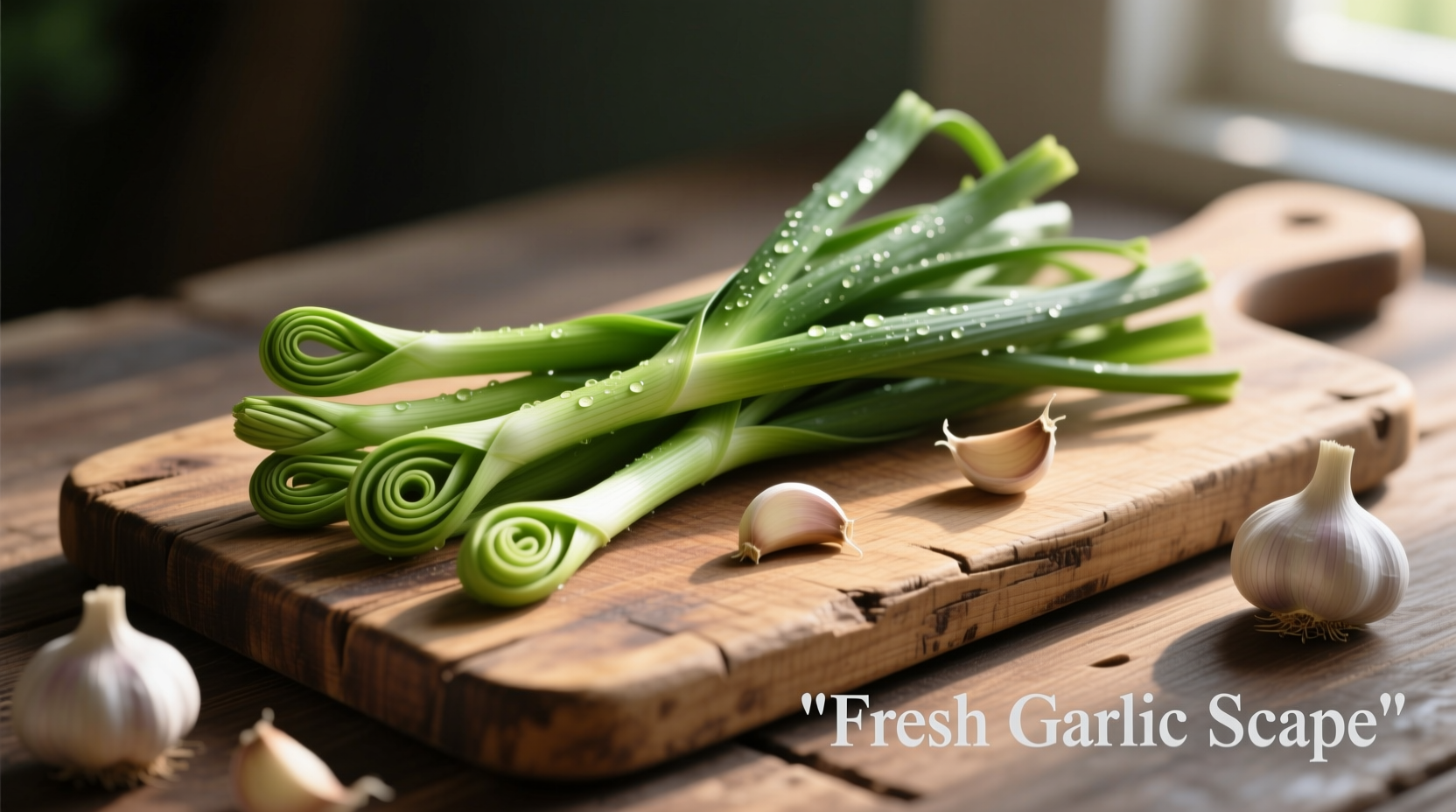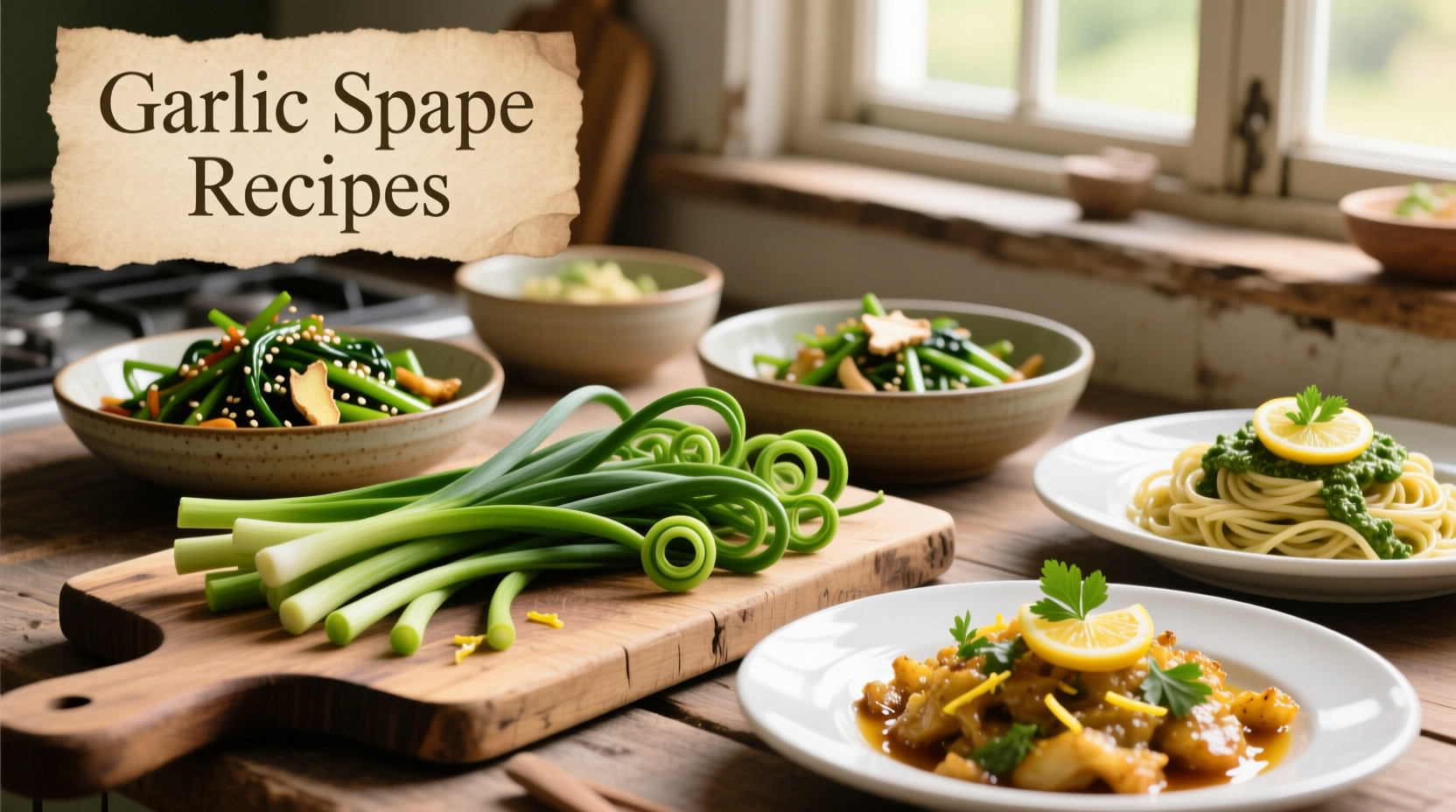Garlic scapes, the curly green shoots of hardneck garlic plants, offer a milder, more nuanced flavor than mature garlic cloves. These seasonal treasures appear briefly each year, creating culinary opportunities that vanish as quickly as summer arrives. Understanding how to select, prepare, and transform these delicate shoots separates novice cooks from those who truly maximize seasonal ingredients.
What Exactly Are Garlic Scapes?
Garlic scapes (Allium sativum) represent the flowering stalks of hardneck garlic varieties. Farmers remove these stalks to direct the plant's energy toward bulb development, making scapes a sustainable byproduct of garlic cultivation. Unlike mature garlic cloves, scapes deliver a subtle garlic essence with grassy, vegetal notes that won't overpower dishes.
| Characteristic | Garlic Scapes | Mature Garlic Cloves |
|---|---|---|
| Flavor Profile | Mild, grassy, subtle garlic notes | Intense, pungent, sharp |
| Texture | Crisp when raw, tender when cooked | Firm, requires mincing |
| Seasonality | Late spring to early summer (4-6 week window) | Year-round (stored bulbs) |
| Preparation Time | 5 minutes (simple trimming) | 10+ minutes (peeling, mincing) |
Seasonal Timeline and Availability
Garlic scapes follow a precise seasonal rhythm that varies slightly by climate zone:
- March-April: Garlic plants begin active growth in warming soil
- May: Scapes emerge and begin curling (prime harvesting window begins)
- June: Peak availability at farmers markets (typically first 2-3 weeks)
- July: Scapes become woody and fibrous (season ends)
According to agricultural data from the USDA National Agricultural Statistics Service, garlic scape availability aligns with hardneck garlic cultivation cycles that represent approximately 30% of U.S. garlic production. The narrow harvesting window creates urgency for cooks wanting to capture this seasonal ingredient at its peak.

Essential Preparation Techniques
Proper preparation maximizes garlic scape usability:
Trimming Method
- Remove any papery husk still attached to the scape base
- Cut off the very tip of the flower bud (it can be tough)
- Discard the very bottom 1-2 inches which may be fibrous
- Chop remaining portion according to recipe requirements
Raw vs. Cooked Applications
Understanding context boundaries prevents culinary disappointment:
- Raw applications: Best with young, tender scapes (thin diameter). Ideal for pestos, salad dressings, and compound butters where fresh flavor shines.
- Cooked applications: Works with all maturity levels. Sautéing, grilling, or roasting transforms scapes into sweet, mellow accompaniments for meats, vegetables, and grains.
7 Tested Garlic Scape Recipes
1. Classic Garlic Scape Pesto (Yields 1 cup)
This vibrant pesto captures spring's essence without overwhelming garlic intensity:
- 1 cup chopped garlic scapes (about 8-10 stalks)
- 1/2 cup toasted pine nuts
- 1/2 cup freshly grated Parmesan
- 1/2 cup extra virgin olive oil
- 1/4 cup fresh basil leaves
- Salt to taste
Combine all ingredients in food processor. Pulse until smooth, adding additional oil if needed. Toss with pasta or use as sandwich spread. Keeps refrigerated for 5 days or frozen for 3 months.
2. Simple Grilled Garlic Scapes
Transform scapes into elegant side dish with minimal effort:
- Toss 15-20 scapes with 2 tbsp olive oil, 1/4 tsp salt
- Grill over medium heat 3-4 minutes per side until tender-crisp
- Squeeze fresh lemon juice before serving
Perfect alongside grilled meats or fish. The high heat caramelizes natural sugars while preserving delicate texture.
3. Quick Garlic Scape Stir-fry
Weeknight dinner solution using seasonal ingredients:
- Slice 10 scapes diagonally into 1-inch pieces
- Stir-fry with mixed vegetables (bell peppers, snap peas) in sesame oil
- Add protein (tofu, chicken, shrimp) and 2 tbsp soy sauce
- Cook until scapes turn bright green (2-3 minutes)
The scapes' mild garlic flavor permeates the dish without dominating other ingredients.
4. Creamy Garlic Scape Soup
Spring's answer to classic potato-leek soup:
- Sauté 1 chopped onion and 2 cups chopped scapes in butter
- Add 2 cups vegetable broth and 1.5 cups diced potatoes
- Simmer until potatoes are tender (15 minutes)
- Blend until smooth, season with salt and white pepper
Serve with a swirl of crème fraîche. The soup showcases scapes' subtle garlic notes without harshness.
5. Pickled Garlic Scapes
Preserve the season's bounty for year-round enjoyment:
- Combine 1 cup vinegar, 1 cup water, 2 tbsp sugar, 1.5 tsp salt
- Add 15-20 prepared scapes to clean pint jar
- Pour hot brine over scapes, leave 1/2 inch headspace
- Seal and process in water bath for 10 minutes
According to National Center for Home Food Preservation guidelines, properly canned garlic scapes maintain quality for 12-18 months. The pickling process transforms their flavor into a bright, tangy condiment.
6. Garlic Scape Compound Butter
Versatile flavor booster for multiple applications:
- Beat 1 stick softened butter with 1/4 cup finely minced scapes
- Add 1 tbsp lemon zest and 1/4 tsp salt
- Roll into log using parchment paper
- Chill until firm
Use to finish grilled meats, melt over roasted vegetables, or spread on crusty bread. The butter captures the scapes' essence while mellowing their raw bite.
7. Garlic Scape Chimichurri
Latin-inspired sauce with subtle garlic notes:
- Finely chop 10 scapes, 1/4 cup parsley, 2 tbsp oregano
- Mix with 1/2 cup olive oil, 2 tbsp red wine vinegar
- Add 1 minced shallot and pinch of red pepper flakes
- Season with salt and let flavors meld 1 hour
This variation on traditional chimichurri offers garlic flavor without overwhelming heat. Perfect for grilled steak or roasted vegetables.
Pro Tips for Maximizing Garlic Scapes
Professional techniques elevate home cooking:
- Storage: Keep unwashed scapes in perforated bag in vegetable drawer. They maintain quality for 7-10 days. For longer storage, freeze chopped scapes in oil.
- Flavor Pairing: Complements spring ingredients like asparagus, peas, and new potatoes. Pairs well with lemon, herbs, and mild cheeses.
- Maturity Matters: Younger scapes work better raw; older, thicker scapes benefit from cooking which softens fibrous texture.
- Substitutions: If unavailable, use 1 part garlic cloves to 3 parts green onions for similar flavor profile.
Finding and Selecting Quality Garlic Scapes
Source the best seasonal specimens:
- Visit farmers markets during May-June for peak freshness
- Select bright green, firm stalks without yellowing
- Choose scapes with tight flower buds (indicates youth)
- Avoid woody or overly thick stalks which indicate maturity
When properly selected and prepared, garlic scapes transform ordinary dishes into seasonal celebrations. Their brief appearance makes them a culinary event worth anticipating each spring. By mastering these techniques and recipes, you'll capture spring's essence in every bite while minimizing food waste through creative preservation methods.











 浙公网安备
33010002000092号
浙公网安备
33010002000092号 浙B2-20120091-4
浙B2-20120091-4